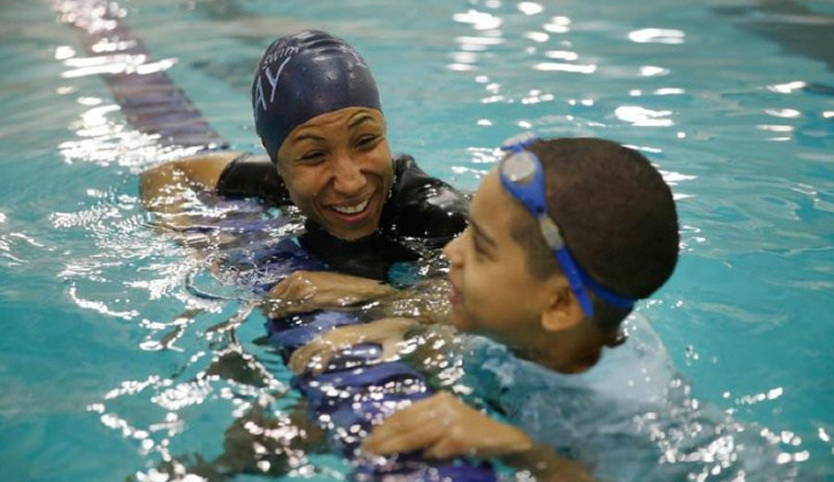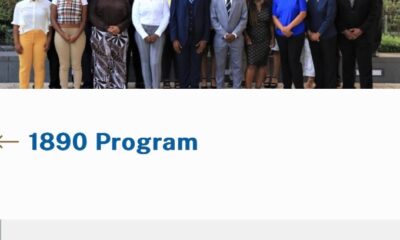News
Drowning in Fear and Discrimination: Why Many Blacks Don’t Swim

By Kimathi T. Lewis
Black children are drowning at a higher rate than whites in America, and a professor at the University of Memphis helped conduct a survey in at-risk communities to find out why.
As Dr. Carol Irvin posed her questions to the receptionist at a YMCA in Philadelphia, the woman seemed mildly interested.
“’I’m not going to get my children into swimming,’” said the receptionist, a black woman with three children.
Puzzled, the professor wanted to know why.
“Because there is no swimming pool nearby.”
Irwin looked to the right towards the door that led to the YMCA’s swimming pool but said nothing. It was 2008, the first time Irwin would encounter such an attitude, but it wouldn’t be the last.
The University conducted the survey again in 2010 — the same year the family members of six teenagers watched helplessly as their children drowned in the Red River outside Shreveport, Lousiana.
The teens had attempted to rescue their cousin and friend, 15-year-old DeKendrix Warner, who had slipped off a ledge, according to news reports. They rushed into the 25-foot deep water to help him, but none of them could swim. Soon they were all thrashing around and crying for help. A man nearby heard their screams, jumped into the water and grabbed the nearest teen, Warner. The bodies of the others were found hours later at the bottom of the river.
Their deaths made national news, highlighting a disturbing disparity: Black children were far less likely to know how to swim than whites.
According to the national study commissioned by USA Swimming and conducted by the University of Memphis, approximately 69 percent of African American youth and 58 percent Hispanic/Latino children reported a “no or low” swimming ability compared to 42 percent of their white peers.
From 2005 to 2014, an average of 3,536 people drowned annually in the United States, the Center for Disease Control reported last year. And about one in five of those who drowned were children 14 years old and younger.
Most of those children were African Americans, Irwin said. Black children drown at three times the rate of white children, she said. The University’s researchers were attempting to learn why.
The study, which consisted of surveys handed out through the YMCA in various cities, provided a variety of answers including: low income; lack of parental encouragement; lack of access, and how the water and chemicals affect black people’s hair, skin and eyes. Some also thought it was just something white people do. But Irwin said the primary factor was fear.
“We definitely saw it in three generations— a legacy of fear,” Irwin said.
A Legacy of Fear
Joy Sanders felt around with her feet until she touched the plastic object that looked like a hockey puck at the bottom of the pool. Swimming was a requirement at her high school in Illinois, but Sanders was too scared to learn. So, she cheated.
Her eyes closed, Sanders held her breath as she went under the water to retrieve the puck that her teacher had thrown into the water. Then she scrambled out of the pool. Anything above her shoulder made her nervous.
By her senior year, her teacher felt sorry for her and let her pass. It would be decades later before Sanders attempted to learn how to swim again.
She’s still not sure why she was so afraid.
“I don’t know. Just the thought of this huge body of water outside of a tub is overwhelming,” Sanders, 45, said.
Irwin said the study showed that some were so afraid they didn’t like splashing water on their faces.
“The data showed their parents told them not to go near water, then they told their children not to go near water,” she said. “It was beaten into their heads to stay away from water if you don’t want to drown.”
LaKesha Gage-Woodard said she grew up across the street from a swimming pool in Chicago, but never learned how to swim. Now she wants to learn how to swim like a fish.
“My brother couldn’t swim, I couldn’t swim. My parents couldn’t swim and I don’t believe my grandparents could swim,” Gage-Woodard, 44, said.
Though she had swimming classes in high school, she said she could never get comfortable in the water. But it was on her Bucket list to learn and in 2016, Woodard began taking classes.
“I just feel like it’s important, that everyone should learn how to swim,” Gage-Woodard said.
Irwin said she is not sure what’s causing the fear.
“There is very little written down about this subject. Some link it to slavery, that owners didn’t want to teach slaves to swim because they didn’t want them to escape.”
But some believe it goes back even further when Africans were being taken through the Middle Passage. They believe it’s an ancestral legacy that led black parents to live under terror — a terror they in turn taught their children.
Micael Shaleak, 55, said the pain of slavery is still very present and, therefore, so is the fear.
“It’s scary, cause in the water we lost,” Shaleak said. “We jumped over, some of us were pushed in and became food for the sharks. Maybe that’s why I’ve never been on a cruise.”
The stories are told of how slaves, in one case as many as 54, were chained together and thrown overboard because of a disease outbreak. Another report said 78 others were killed in the same way over two days.
“Fear is a powerful thing. It will shut you down,” Shaleak said. “Fear got us so locked down we can’t even get into the water.”
Lack of Access – A Deadly Legacy of Swimming Pool Discrimination
Still, Jeff Wiltse, author of Contested Waters, believes that the discrimination against black Americans that governed the 20th Century is the reason why they are less likely to know how to swim than whites.
In his article, “The Black-White Swimming Disparity in America: A Deadly Legacy of Swimming Pool Discrimination,” Wiltse said the discrimination took several forms.
Public officials and white swimmers would deny black Americans access to pools earmarked for whites while the cities provided few pools that were often small and dilapidated for blacks, Wiltse said.
After desegregation, the cities also closed many public pools and the YMCA also restricted access to their pools.
Sanders doesn’t discount the fear factor, but she agreed with Wiltse, especially since she saw a documentary that backed up his argument about black people being banned from pools.
“We couldn’t use the same bathroom or drink from the same faucet so of course they wouldn’t allow us in the pools,” Sanders said. “They thought they would catch something from us.”
Wiltse, an associate professor at the University of Montana, said because of this lack of access, swimming never became part of black Americans’ recreation and sports culture.
Still, Irwin said she can see some changes. In the third study conducted this year, she said there was a five percent improvement in learning how to swim for all groups.
“You can save your child’s life by putting them in swimming,” she said.

-

 Featured10 months ago
Featured10 months agoCalifornia Is the First State to Create A Public Alert for Missing Black Youth
-

 Featured9 months ago
Featured9 months agoAfrican American Leaders Stay the Course Amid Calls for President Biden To Bow Out of Race
-

 Featured10 months ago
Featured10 months agoThe Debate Fallout Lands on Both Candidates
-

 Featured9 months ago
Featured9 months agoPresident Joe Biden Decides to Withdraw from the Presidential Race
-

 Featured9 months ago
Featured9 months agoIn One of His Final Speeches as President, Biden Says It’s Time for ‘Fresh Voices’
-

 Featured9 months ago
Featured9 months agoPresident Joe Biden Describes Shooting of Donald Trump As ‘Sick’









